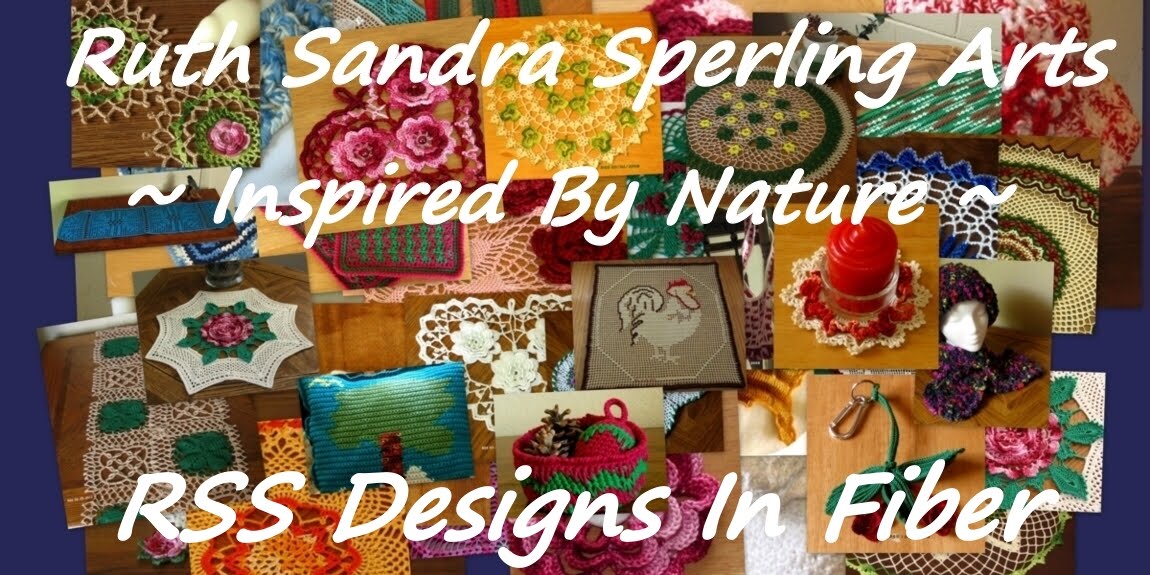Ruth Sandra Sperling
RSS Designs In Fiber -
Internet Shop of Handmade Items In Fibers
Global Warming -- one of the Hottest subjects around these days!!
To start off and establish my stand on this issue, I would like to quote Louis Blumberg of The Nature Conservancy California Office, who works in Forestry and Climate Change for them, from the article, "The Carbon Equation, Can Forests Save Us From Climate Change?" by Jane Braxton Little in the Winter 2009 edition of Nature Conservancy Magazine:
"Nature is our greatest ally in the fight against climate change."Why quote him? Because that is totally how I feel and I feel that is the only realistic solution to what I call "un-natural Global Warming".
I am not always sure that people understand it overall. Some do and some don't. Climate Change to some degree happens naturally and geologically all the time on our planet. Geologically there are warming periods and cooling periods. If you read scientific journals and about Geology and about Paleontology, you will see discussions about it and varying opinions. Historically on Earth, there is documented information about warming periods and cooling periods in past centuries and eras -- and what happened as a result of these warming and cooling periods.
To some extent, some scientists are trying to make predictions based on historical occurrences on the planet -- and based on scientific documentation of evidence of Global Warming now -- such as glaciers and ice sheets melting.
The huge question seems to be -- how much of this Global Warming is natural, since the planet is in a geological warming period anyway? And how much of it can we do anything about to slow Global Warming and protect our own human habitat?
As an environmentalist, forests are some of my favorite places to go and get protected and therefore study, so I will focus on this.Being in a warming period is significant to forestry scientists as it affects the species in the forests -- and the health of certain species in the forests and their growth -- and possibly significant changes in the makeup of a forest ecosystem - whether it is natural warming and/or the result of human-caused warming.
Various human actions on the planet affect Global Warming by increasing carbon emissions into the atmosphere -- various activites directly related to the industrial age for sure increase carbon emissions into the atmosphere.
But one of the human activites that has resulted in a high percentage of carbon emissions is that of Deforestation and Forest Degradation -- and that we can do something about. And this is the main point of this blog article.Just looking at the fact of how much forest has been cut down over this planet in the last few centuries boggles the mind - at least mine. Looking at facts like part(s) of the Sahara Desert use to be forest that was cut down centuries ago (I don't know exactly what parts geographically) - this deforestation has been going on a long time -- and all the forests that have been and still are being cut down for building cities, towns, agricultural sites -- it looks to me like only a fraction of the original forest on our planet is left. And much did not come down naturally. As trees provide the natural benefits of holding water in the soils/lands, shading and keeping the lands cooler -- as well as storing carbon, it is obvious to me that cutting down huge areas of forest over the planet has contributed to Global Warming and that is human-caused!!
Therefore, we need to look at what we can do about it.
One of the Forestry scientists that I admire and respect for his perspective on forest, forest health and ecological integrity and forest restoration is Dr. Jerry F. Franklin, a Professor in Forest Resources at the University of Washington in the State of Washington.
I first became acquainted with his work in forestry when I became involved with the Sierra Nevada Forest Protection Campaign and their Conservation Strategy for the Management of the Sierra Nevada National Forests; this Conservation Strategy is based on the Sierra Nevada Ecosystem Project (SNEP -
http://ceres.ca.gov/snep/), which was commissioned by the United States Congress -- and Dr. Jerry F. Franklin is one of the SNEP authors. He also was one of the speakers at the Sierra Nevada Old Forests Public Science Workshop put on by the Sierra Nevada Framework for Conservation and Collaboration, Pacific Southwest Region and Research of the USDA Forest Service on August 24-25, 1999 at UC Davis -- which I attended.
Earlier this year, I emailed Dr. Jerry F. Franklin particularly about his opinion regarding the role of forests in dealing with Global Warming -- and I got his permission to quote him:
"Ruth: Actually we have a much greater percentage of the forest remaining on the
planet than 4% although I cannot tell you the exact percentage. Certainly the
forests do help cool things but, preversely, they may also help warm the planet
as well, due to the fact that they have such a low albedo -- i.e., they retain
most of the energy that they absorb from the sun. It really is very complicated
and I don't think that we have it all figured out yet. Certainly, we should not
be cutting down any of our remaining old-growth forests in the moist temperate
regions and in dry forest regions, like much of the Sierras, we should be
retaining all of the old trees and trying to grow more big old trees, as well,
since they are likely to be more resistent to both wildfire and climate change.
Planting trees is certainly a good thing to be doing and they certainly
can modify the environments in places that we live as well as help modify carbon
balances and climate throughout the globe. Fundamentally a good thing to do. On
the other hand, it is very important to do some active forest restoration in the
Sierra Nevada because many of the forests in your area are simply too dense for
their own good. Any restoration should retain the old trees and, even more,
enhance their potentiall for survival by removing fuels and competing vegetation
around the existing old trees. There is a very good recent PSW Research Station
General Technical Report by Malcolm North and others that has some very good
recommendations for restoring the mixed-conifer forests in the Sierra Nevada.
Jerry"
I noted here in his statement that not only planting trees is important, but proper management of the forests -- to not be too dense and to "enhance their potential for survival by removing fuels and competing vegetation around the existing old trees" -- this is something I learned about when listening to forestry scientists talk about "protecting Old Growth", which also means encouraging "Old Growth characterisitics", which in many cases will require the removal of smaller, undergrowth trees and the competing vegetation (as Dr. Jerry F. Franklin states) to allow the larger trees to grow even larger -- as well as not removing the Old Growth, which is the popular environmental stand!
It is faster-growing trees with large canopies that will naturally store carbon through the natural process of Photosynthesis.There are various projects and studies going on -- and with the advent of the California Climate Action Registry (CCAR) and California Assembly Bill 32, it looks like carbon offset programs by protecting and managing private forests for "forest carbon offset credits" may result in more.
One such forest project being managed is in fact a forest restoration project which The Nature Conservancy got involved with as a partner by paying for a Conservation Easement on a working forest prohibiting future development and managing this forest for restoration and carbon-sequestering potential. It is presently a relaitvely young Northern California Coastal Redwood forest that has been commercially logged again and again in the past by timber companies - but the fast-growing young trees in this Coastal Redwood forest have a huge potential for storing carbon as they grow per scientific analysis -- and this is proving to be a successful source of forest carbon credits. It is the "Garcia River Forest Project" -- my information is from The Nature Conservancy article quoted at the beginning of this blog post, which is online at http://www.nature.org/magazine/winter2009/features/index.html -- and from The Nature Conservancy website: http://www.nature.org/initiatives/climatechange/work/art23798.html .One solution -- support Forestry Projects such as this to slow Global Warming!!
Another Solution from The Nature Conservancy -- Plant A Billion Trees in the Atlantic Forest of Brazil: http://www.plantabillion.org/ (the widget for this is on the left here on my blog!!)
Another solution, this one from Conservation International -- support the Actions being taken by Conservation International to Stabilize Climate through their programs for "Protecting forests and other ecosystems as a solution to climate change" as given at http://www.conservation.org/learn/climate/Pages/overview.aspx :
1. Saving Forests http://www.conservation.org/forests2. High Forest Cover, Low Deforestation (HFLD) http://www.conservation.org/learn/climate/pages/climate_change_hfld.aspx3. Reducing Emissions From Deforestation and Forest Degradation (REDD) http://www.conservation.org/learn/climate/pages/climate_redd.aspxTAKE ACTION BY PROTECTING AN ACRE OF FOREST THROUGH CONSERVATION INTERNATIONAL FOR $15 http://www.conservation.org/protectanacreAlso, one of my favorite solutions to suggest to people to help with reducing some carbon emissions in their everyday lives -- is to buy and do Handmade!! There are so many ways to do this!!
Handmade causes much lower, if any, carbon emissions.My Handmade crocheted and knitted items (for sale at
http://rssdesignsinfiber.etsy.com/ ), made by either natural light or various forms of energy-saving flourescent lighting, certainly results in less carbon emissions than the similar items that are mass-produced on machines which generate lots of carbon emissions. There are many places where you can buy Handmade online - I am on
http://www.etsy.com/, which is a website for Sellers and Buyers of Handmade, Vintage and Supplies for Handmade.
Also -- I encourage Local Harvest and getting foods locally as much as possible as that is part of a "low carbon" life, also!!
Resolutions can be a good thing -- they are postulates for what you choose to do in your life -- New Year has been a popular time of the year to make them, though I personally believe you should not limit yourself to just then to make Resolutions for living a better life!!
And I can't think of a better New Year's Resolution than to find ways to live your life and support activities that can help
SLOW Global Warming!!














 Wild Rose Heart with Garnet Roses
Wild Rose Heart with Garnet Roses





















